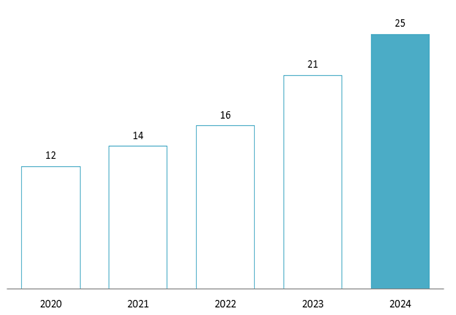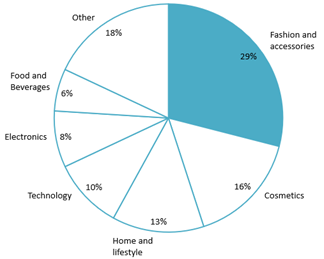
231월2025
최신 뉴스 및 보고서 / 베트남 브리핑
댓글: 댓글 없음.
베트남의 전자상거래 시장은 2024년에 괄목할 만한 성장을 기록하며 동남아시아 디지털 강국으로서의 입지를 공고히 했습니다. 스마트폰 보급률 증가, 기술에 능숙한 젊은 인구, 그리고 정부 지원 정책이 이러한 성장을 견인했습니다. 2025년이 다가오고 미래를 내다보면서, 베트남의 전자상거래 환경은 변화, 지속가능성 추구, 그리고 국경 간 무역 기회 확대를 향해 나아가고 있습니다.
2024년 베트남 전자상거래 시장
베트남의 전자상거래 시장은 2024년에 250억 달러를 돌파할 것으로 예상되며, 이는 2023년 대비 20% 증가한 수치입니다. 베트남의 전자상거래는 국가 디지털 경제 총 가치의 3분의 2를 차지하고 전국의 총 소매 상품 및 소비자 서비스 수익의 9%를 차지합니다.[1]동남아시아 지역 내에서 베트남의 전자상거래 시장은 인도네시아와 태국에 이어 3위를 차지하고 있습니다.
Vietnam’s e-commerce market value from 2020 to 2024
단위: 10억 달러
출처: 산업통상부
또한 베트남의 전자상거래 플랫폼, 특히 TikTok Shop과 Shopee는 상당한 성장을 보였으며, 2024년 매출은 각각 1,51%와 66% 증가했습니다. 2024년 6월까지 베트남 내 모든 전자상거래 플랫폼의 총 매출은 미화 30억 달러에 달했습니다. 제품 카테고리 중에서는 패션과 액세서리가 시장을 주도하며 거의 10억 달러를 기록했습니다. 그 외에도 화장품, 홈 및 라이프스타일 제품, 기술, 가전제품 등이 높은 성장률을 기록했습니다.
6월까지 베트남 전자상거래 플랫폼 부문별 매출 2024
원천: 액세스트레이드
전자상거래의 급속한 성장은 온라인 플랫폼을 통한 수출 성장의 발판을 마련했습니다. 베트남의 B2C 전자상거래 수출액은 2028년까지 약 60억 달러에 이를 것으로 예상되며, 중소기업(MSME)이 이러한 성장에 25%를 기여할 것으로 예상됩니다.[2]. 중소기업의 주요 수출 목적지에는 중국, 미국, 일본과 같은 주요 시장과 영국, 유럽, 동아시아의 새로운 기회가 포함됩니다.[3].
시장 성장을 위한 기회와 과제
2024년까지 베트남의 인터넷 사용자는 약 7,900만 명으로, 이는 국가 인구의 79%에 해당합니다.[4]. 거의 100% 모바일 연결과 결합되어 전자 상거래는 도시와 농촌 지역 모두에 도달하여 광범위하게 확장될 수 있었습니다.[5]. 같은 해 온라인 결제 시장 규모는 1,490억 달러로 전년 대비 18% 증가했으며, 2030년까지 3,500억 달러에 이를 것으로 전망됩니다.[6]디지털 결제 플랫폼의 등장으로 거래가 더욱 원활해지면서 고객의 온라인 쇼핑이 더욱 편리해졌습니다. 이러한 무현금 결제로의 전환은 전자상거래 성장에 필수적이며, 소비자에게 안전하고 효율적인 옵션을 제공합니다. 최근 300명의 응답자를 대상으로 한 Q&Me 설문조사에서 81%는 최소 한 달에 한 번 이상 구매한다고 답한 반면, 나머지 19%는 한 달에 한 번 이하로 구매 빈도가 낮았습니다.
도시 지역의 발전에도 불구하고, 낙후된 인프라로 인해 외딴 지역과 농촌 지역으로의 상품 배송은 여전히 어려운 과제로 남아 있습니다. 이러한 제약은 배송 시간에 영향을 미치고 운영 비용을 증가시켜 이러한 지역으로의 전자상거래 확장을 저해합니다.[7]또한, 쇼피(Shopee)와 틱톡(TikTok) 등 주요 전자상거래 플랫폼에서는 위조품과 저품질 상품이 여전히 만연한 문제로 남아 있습니다. 많은 판매자가 롤렉스, 아디다스, 나이키, 세라브(Cerave) 등 유명 브랜드의 위조 상품을 공개적으로 판매하고 있습니다. 이로 인해 소비자들은 제품 진위 여부에 대한 우려가 커졌고, 일부 고객은 신뢰할 수 있는 오프라인 매장에서 직접 구매하는 것을 선호하게 되었습니다.[8].
또 다른 중요한 과제는 베트남의 고급 인력 부족입니다. AccessTrade가 200개 중소기업을 대상으로 실시한 설문조사에 따르면, 응답자의 95%가 숙련된 인력 부족으로 어려움을 겪고 있다고 답했습니다. 가장 수요가 높은 주요 직종으로는 전자상거래 소프트웨어 개발자(67%), 디지털 마케팅 전문가(63%), 공급망 및 물류 전문가(62%), 다국어 고객 서비스 담당자(49%) 등이 있습니다. 이러한 인력 부족은 기업이 전자상거래 부문의 운영 수요를 충족하고 성장을 지속하는 데 상당한 영향을 미칩니다.[9].
베트남 전자상거래 시장의 미래 전망
베트남은 향후 몇 년 동안 18~20%의 CAGR로 꾸준한 전자상거래 성장을 유지하고 있습니다. 2030년까지 시장 규모는 630억 달러에 이를 것으로 예상됩니다. 베트남의 전략적 위치와 CPTPP, EVFTA, RCEP와 같은 무역 협정 참여는 베트남을 국경 간 전자상거래의 허브로 자리매김하여 수출 기회를 더욱 확대합니다. TikTok Shop 및 Shopee와 같은 소셜 커머스 플랫폼의 통합은 기업이 젊고 기술에 정통한 세대와 소통하는 방식을 바꾸고 있습니다. 2025년에 발표될 예정인 2026~2030년 기간의 전자상거래 개발을 위한 국가 기본 계획에 대한 정부의 초안과 결합하여 부처 및 기관의 목표와 책임을 설명함으로써 베트남은 동남아시아의 선도적인 전자상거래 중심지로 자리 매김하는 것을 목표로 합니다.
– 전자상거래 소매 판매는 연간 20~30% 성장할 것으로 예상되며, 이는 국가 전체 상품 소매 판매의 20%를 차지할 것입니다.
– 전자상거래를 도입하는 기업 비중은 70%를 초과하는 것을 목표로 합니다.
– 60% 고등교육 및 직업훈련기관은 전자상거래 관련 분야에서 전문교육 프로그램을 시행할 예정입니다.
다양한 국제 전자상거래 플랫폼의 참여로 전자상거래 시장은 앞으로 더욱 성장할 것으로 예상됩니다. 특히, 2024년 베트남은 중국 최대 전자상거래 플랫폼인 테무(Temu)와 세인(Shein)의 진출을 환영했습니다. 그러나 이 두 거대 전자상거래 플랫폼은 필요한 절차를 완료해야 했기 때문에 곧 운영을 중단해야 했습니다.[10]그럼에도 불구하고, 이러한 상황은 베트남 전자상거래 시장의 잠재력을 잘 보여줍니다. 많은 유명 기업이 이 매력적인 시장에 진출할 준비가 되어 있거나 진출을 계획하고 있기 때문입니다.
결론
베트남의 전자상거래 시장은 동남아시아 디지털 경제의 핵심 동력으로, 인터넷 접근성 향상과 정부 지원 정책에 힘입어 강력한 성장을 이루고 있습니다. 인프라와 소비자 신뢰도 등의 과제는 여전히 남아 있지만, 국경 간 무역은 여전히 엄청난 기회를 제공합니다. 베트남은 이러한 난관을 극복함으로써 전자상거래 분야의 지역 리더로서의 입지를 공고히 하고 기업과 소비자에게 밝은 미래를 제공할 것입니다.
[1] 산업통상부 웹 포털(2025). 전자상거래는 베트남 디지털 경제의 3분의 2를 차지합니다.입장>
[2] The Vietnam Plus 신문(2024). 2024년 베트남 전자상거래 붐입장>
[3] 액세스 파트너십(2024). 베트남의 전자상거래 혁명입장>
[4] Datareportal(2024). 2024년 베트남의 디지털입장>
[5] 라오동 신문(2024). 베트남 모바일 연결 속도 거의 100%에 도달입장>
[6] 구글 E-conomy SEA(2024). 베트남 E-conomy 보고서입장>
[7] 세빌스 베트남(2024). 베트남 전자상거래: 급속한 성장과 시장 확대입장>
[8] 다이 비에우 냔 단 신문(2023). 전자상거래 플랫폼의 위조 제품입장>
[9] 액세스 파트너십(2024). 베트남의 전자상거래 혁명입장>
[10] 로이터(2024). 테무와 셰인, 베트남 작전 중단입장>
* 본 기사의 내용을 인용하고자 하시는 경우, 저작권을 존중하여 출처와 원 기사의 링크를 함께 명시해 주시기 바랍니다.
| 비앤컴퍼니
2008년부터 베트남에서 시장 조사를 전문으로 하는 최초의 일본 기업입니다. 업계 보고서, 업계 인터뷰, 소비자 설문 조사, 비즈니스 매칭을 포함한 광범위한 서비스를 제공합니다. 또한, 최근 베트남에서 900,000개 이상의 기업에 대한 데이터베이스를 개발하여 파트너를 검색하고 시장을 분석하는 데 사용할 수 있습니다. 문의사항이 있으시면 언제든지 문의해주세요. info@b-company.jp + (84) 28 3910 3913 |




